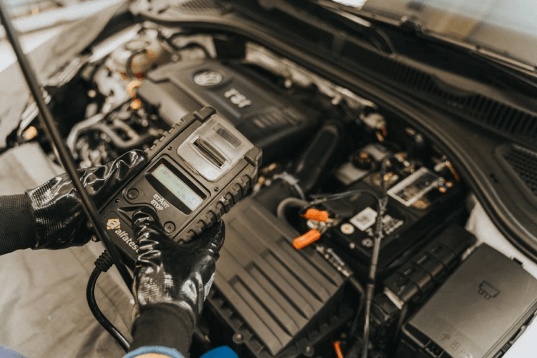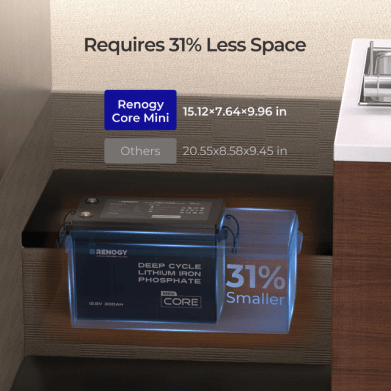How Many Volts to Start A Car
Picture this: You're at a peaceful campsite, surrounded by nature, ready to head out for your next adventure. But when you turn the key in your car's ignition, all you hear is a faint clicking sound, and the dashboard lights barely flicker. This frustrating scenario, all too familiar to many RV enthusiasts, often points to one common issue - insufficient car battery voltage.
Your RV's battery plays a crucial role: it provides the initial electrical surge needed to crank the starter motor, which in turn gets your engine running. It also powers essential electronics when the engine isn't running. So, how many volts to start a car?
In simple terms, most modern cars require a minimum of 12 volts to start properly. A healthy car battery should ideally provide 12.6 volts, and when the voltage drops below 12 volts, you might find yourself stranded at your campsite with a vehicle that won't start.
Understanding this crucial threshold not only helps you identify potential battery issues early but also ensures you won't face the inconvenience of a failed start when you're ready to move on to your next destination.
What is Car Battery Voltage

Car battery voltage is a measure of electrical pressure of cars - it represents how strongly electricity is being pushed through a circuit, much like water pressure in a pipe. In automotive systems, 12-volt electrical system is actually a complex network that includes the battery, alternator, and various electrical components. though the actual voltage varies with the vehicle's state.
The battery provides initial power to start the engine through the starter motor. Once the engine starts running, the alternator, driven by the engine's belt system, becomes the primary power source. It can power all electrical components (lights, radio, etc.) and simultaneously recharge the battery. This higher voltage from the alternator ensures the battery maintains its charge while also meeting the vehicle's ongoing electrical demands.
How Many Volts to Start A Car
A healthy car battery typically provides 12.6 volts when the engine is off, increases to 13.5-14.5 volts when the engine is running (due to the alternator charging the battery), and temporarily drops to around 10 volts during the high-demand starting process.
As voltage drops to the marginal range of 12.0 to 12.4 volts, you might notice slower cranking, especially in cold weather, signaling it's time for a recharge or battery check.
When readings fall into the critical range of 11.5 to 11.9 volts, starting becomes increasingly uncertain and may require multiple attempts - this is your warning sign to take immediate action.
Below 11.5 volts, your car will likely refuse to start altogether, indicating a severely discharged or failed battery that needs immediate replacement. Remember, these voltage ranges serve as important indicators of your battery's condition and can help prevent unexpected starting failures.
How To Test Car Battery Voltage?

Testing your car battery voltage is a crucial skill for every RV owner. Using a digital multimeter, simply connect the red probe to the positive terminal and the black probe to the negative terminal when the engine is off. A healthy battery should read around 12.6V, giving you a clear indication of your battery's condition.
Why Starting Battery Lose Voltage
The minimum voltage for a car to start is usually around 12 volts. Most car batteries have a voltage of about 12.6 volts when fully charged, and the voltage may temporarily drop to 11 volts or even lower when starting. If the voltage falls below 10.5 volts, it may not be possible to successfully start the engine.
Understanding why the starting battery experiences insufficient voltage is crucial for maintaining reliable vehicle performance. Several factors can contribute to this issue, ranging from battery age and temperature effects to excessive discharge and poor connections.
- Excessive Discharge: If the starting battery is repeatedly drained beyond its capacity, it can result in a significant drop in voltage. This often occurs when accessories are used while the engine is off or if the battery is old and unable to hold a charge effectively.
- Poor Connections: Corroded or loose terminals can create high resistance in the electrical circuit, preventing the battery from delivering sufficient voltage to the starter motor. This can lead to difficulty starting the engine or a complete failure to start.
- Temperature Effects: Extreme temperatures, both hot and cold, can negatively impact a battery’s performance. High temperatures can increase internal resistance, while cold temperatures can reduce the battery's ability to provide the necessary power for starting, leading to a drop in voltage.
Signs of a Weak Battery
Recognizing the red flags of a weak battery or signs of replace a new battery can save you from unexpected breakdowns and ensure your vehicle runs smoothly.
One of the first indicators is slow engine cranking; if your engine struggles to turn over when you start your car, it might be a sign that your battery is losing its charge.
You may might notice dimming headlights or interior lights, especially when you start the engine. If these lights flicker or appear noticeably less bright, it’s time to pay attention if the car battery is dead.
Another telltale sign is a dashboard warning light, many modern vehicles are equipped with battery warning indicators that will alert you if there’s an issue.
Moreover, if your battery is over three years old, it’s wise to have it tested regularly, as age can significantly impact performance. Other symptoms include a strange odor—if you smell sulfur or rotten eggs near the battery, it may be leaking or overheating.
Choose the Right Battery at Renogy

Every car owner knows that reliable power is the lifeline of comfortable travel. Whether you've experienced a heart-stopping moment when your car won't start at a remote campsite, or faced the frustration of a dying battery cutting your evening short – no refrigeration, no air conditioning, and even worse, no morning coffee – power issues can quickly derail your adventure.
The Renogy Core Mini 12.8V 300Ah Lithium Iron Phosphate Battery is designed specifically with these RV challenges in mind. With two Core Mini batteries providing 7680Wh of power, you'll have enough reliable energy to not only ensure confident starts every time but also run your essential appliances – fridge, microwave, coffee maker, and A/C – for over 24 hours.
What truly sets the Core Mini apart is its practical design for RV life. Weighing only 55.1 pounds – significantly lighter than similar batteries – one person can easily handle installation or maintenance. Its compact size preserves valuable RV storage space, while the flexible configuration options allow you to connect up to four batteries in various arrangements to match your power needs.

Concluison
Understanding how many volts to start a car is essential for every car owner - a healthy battery should provide at least 12.6 volts for reliable starting, while readings below 12 volts signal potential issues that need attention. By monitoring your battery's voltage and understanding these key thresholds, you can prevent unexpected starting problems.
How Many Volts To Start A Car FAQs
1. Can a car start with 11.9 volts?
While a car might start with 11.9 volts, it's not recommended to rely on this voltage level. At 11.9V, your battery is critically low and may fail to start, especially in cold weather. This voltage reading indicates your battery needs immediate attention - either a full recharge or replacement to prevent getting stranded.
2. Why does my car battery read 12.4 volts but still won't start?
A 12.4V reading may seem adequate, but starting issues can still occur due to several factors: cold weather reducing battery performance, corroded terminals preventing proper power flow, a weak battery lacking sufficient cranking amps, or problems with the starter motor itself. Have your entire starting system checked if voltage reads okay but starting remains problematic.
3. How long can a car battery last with 12 volts?
A battery showing 12 volts is already partially discharged (about 50% capacity) and shouldn't be relied upon for extended use. While you might get a few more starts, this voltage level indicates you should recharge your battery soon. Without recharging, the battery could drop to critical levels within a few days to weeks, depending on usage and environmental conditions.










